ISSN ONLINE(2278-8875) PRINT (2320-3765)
ISSN ONLINE(2278-8875) PRINT (2320-3765)
| Dr.T.V.U.Kiran Kumar HOD, Dept Of ECE, Bharath University, Chennai – 600073, India |
| Related article at Pubmed, Scholar Google |
Visit for more related articles at International Journal of Advanced Research in Electrical, Electronics and Instrumentation Engineering
In this paper a multiple access channel is considered where there are four users each has its own transmit antenna and a common receiver for these four users where the receiver has four receive antennas. The users know each others channel, the precoders are designed utilizing the channel information to cancel interference at the receiver without sacrificing the diversity or complexity of the system. The precoders that are designed using the channel information makes it possible for different for the four users to transmit the signal orthogonal to each other. Then using orthogonality of the transmitted signal the common receiver can separate the signal from each user and decode the signal independently . The users transmits the data at fixed and variable rate. The modulation scheme used in this paper is QPSK and QAM techniques. The performance of the system is analyzed by comparing simulated results shown by both the modulation techniques.
Keywords |
||||||||
| Quadrature PhaseShift Keying,Quadrature Amplitude modulation, multiple access channel, Precoders, channel information, diversity, orthogonality, fixed data rate, variable data rate. | ||||||||
INTRODUCTION |
||||||||
| There are many fundamental technical challenge present in a wireless communication. Multi path fading, propagation loss ,Bandwidth , time variance and noise makes the signal flow difficult .Further challenges are speed , size of the device and power limitation. Capacity of wireless channel is increased by using more number of antenna at both the ends of the system. Decoding complexity increases When the number of transmit antennas is fixed and it increases exponentially with transmission rate . In this paper, a multiple-antenna multi-access scenario is considered where interference cancellation is achieved in the system by utilizing channel information. By using space–time codes with a multilevel structure his can be implemented [1],[4]. There is a direct relationship between any multiuser detection scheme and a single user modulation scheme with multiple transmit antennas. Once the multiuser scheme is designed one can think of each user as one antenna or a group of antennas embedded in the transmit antenna array of a single transmitter unit. Obtaining the benefits of multiple transmit antennas requires the use of special space-time signaling schemes such as spacetime codes [8] and [12]. Space-time codes are generally referred to as “open-loop” because they operate without the benefit of channel state information at the transmitter. For an example space-time codes are used in third generation cellular networks [5] and are likely to be used in next generation wireless local area networks (LANs) [4]. | ||||||||
| Orthogonal space-time block codes (OSTBCs) are perhaps the most practical space-time codes due to the simplicity of optimal decoding. Further compared with low-complexity Space-time coding OSTBC is a powerful tool for achieving diversity and coding gain over multi-input multi-output (MIMO) fading channels. The code design assumes that the transmit and receive antennas are uncorrelated and each element of the MIMO channel matrix fades independently. In this paper to improve the performance of the system feedback is used at the transmitter . Limited feedback can be used to increase the performance of a MIMO system increased [8],[10]. In this paper maximum-likelihood detection is used at the receiving side and by using this full diversity for each user is achieved. But by the above technique complexity increases depending upon the number of antennas used in the system. To overcome this drawback in [6],[15] precoders are designed using channel information. This information at the transmitter aligns different groups of signals along orthogonal directions[11],[13]. As a result, interference cancellation is achieved in the system without utilizing the receive antenna resources and full diversity is achieved for the system .In this paper, a scheme is proposed that works for four users each with four transmit antenna at the transmitter and one receiver with four antennas[14]. | ||||||||
SYSTEM DESIGN |
||||||||
| Rayleigh fading channel model is used in this system. Orthogonal space –time block codes (OSTBC) is used that achieves full diversity order in the system . The data rates can be fixed data rate or variable data rate. In this paper there are four users each has its own transmit antenna and a common receiver for these four users where the receiver has four receive antennas four users. | ||||||||
| The precoder matrix for users 1,2,3,4 at the lth time slot is given by | ||||||||
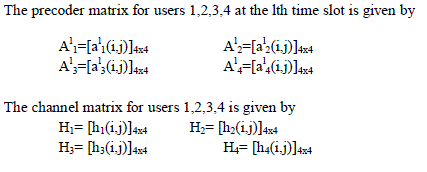 |
||||||||
| In every four time slots, users 1,2,3,4 send Quasi Orthogonal Space Time Block Codes (QOSTBC) | ||||||||
| To cancel interference the input output equation is given by | ||||||||
 |
||||||||
| The precoders are choosen such that they provide full diversity and cancel interference for each user in the system. The symbols of the four users are transmitted along four orthogonal directions to cancel interference as shown in fig .2. | ||||||||
| Alamouti proposed a structure to cancel interference and obtain full diversity but it works only for two users. So in this paper we use quasi orthogonal structure but it cannot achieve full interference cancellation for each user due to its nonorthogonality. To tackle all the above problems together, we propose a new precoder design scheme as follows.At each of the first 2 time slots, we design precoders such that symbols of User 1and symbols of User 2 are transmitted orthogonal to each other. Each element of the equivalent channel matrices for Users 1 and 2 is still Gaussian. This property is critical to achieve full diversity for Users 1 and 2 .Then we design precoders for Users 3 and 4, such that the transmit directions of their signals are orthogonal to each other. Note that it is impossible to obtain this orthogonal structure and make each element of the equivalent channel matrices for Users 3 and 4 still Gaussian. This is the main difference between the precoders for Users 1, 2 and the precoders for Users 3, 4, at the first 2 time slots. At the second 2 time slots, we also design precoders to make the transmit directions of signals orthogonal to each other. However, we design the precoders for Users 3 and 4 first, such that each element of the equivalent channel matrices for Users 3 and 4 is Gaussian. Then we design the precoders for Users 1 and 2 to obtain the orthogonal structure. As a result, elements of the equivalent channel matrices for Users 1 and 2 will not be Gaussian at the second 2 time slots. By this way we can achieve interference cancellation and full diversity for each user. | ||||||||
| The precoder is designed between user 1 and 2 at time | ||||||||
| slot 1 to have orthogonality such that | ||||||||
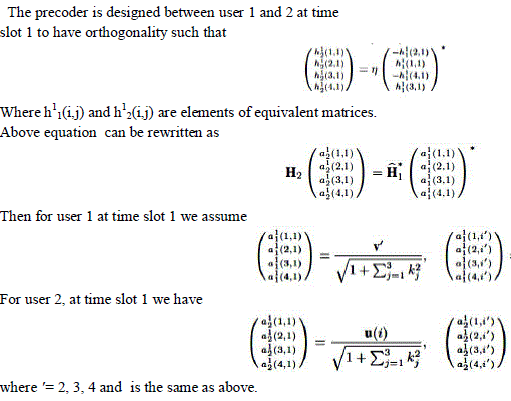 |
||||||||
| the signals of User 1 and User 2 will betransmitted along two orthogonal directions as shown in Figure2.In order to derive the orthogonality among Users 1, 2, 3 attime slot 1, we design precoderA1 3to satisfy the followingproperties | ||||||||
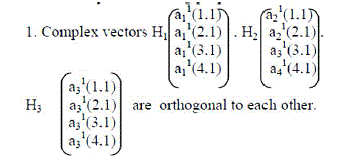 |
||||||||
 |
||||||||
| 3.The Frobenious norm of complex matrix A3 1 is equal to 1.In order to maximize the coding gain,A3 1 can be further chosen numerically such that the norm of H3A3 1 is maximized. Design of A1 4, A2 3, A2 4 is similar to that of A1 3. | ||||||||
DECODING |
||||||||
| The decoding is carried out at the receiver where there is only one common receiver for the four users and there are four antennas at the receiver . The precoders are designed at the receiver to decode the signal individually which forms four codewords separately and then Maximum-Likelihood method is used to detect the real and imaginary parts of these 4 codewords separately | ||||||||
| Using precoders, Equation (5) becomes | ||||||||
 |
||||||||
PROOF OF FULL DIVERSITY |
||||||||
| Diversity is defined as | ||||||||
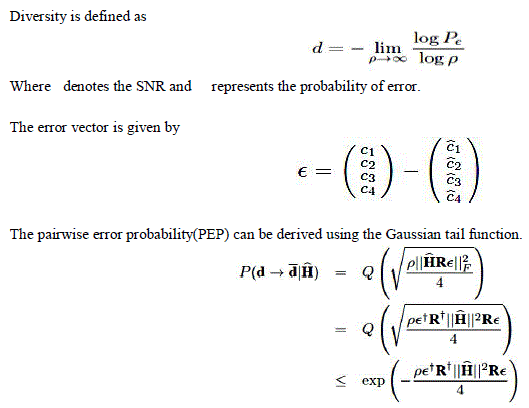 |
||||||||
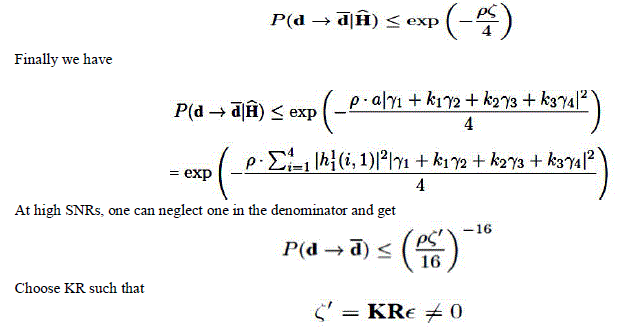 |
||||||||
| Therefore, by using our scheme, User 1 can achieve full diversity. In addition, in order to maximize the coding gain, we need to choose KR such that the minimum possible norm of KR is maximized. Similarly, we can also prove that the diversity for Users 2, 3, 4, is 16 as well. Therefore, our scheme can achieve full diversity for each user. So using our scheme, the pairwise error probability can always be upper bounded by | ||||||||
 |
||||||||
| This means that the proposed procedure is universal in that it can achieve the maximum possible diversity over any fading distribution. | ||||||||
SIMULATION RESULTS |
||||||||
| In this section, the simulation results are given that confirm the analysis in the previous session. Fig 3 gives the simulated results for four users each with four transmit antennas and one receiver with four receive antennas.Our scheme also cancels the interference completely but provides a diversity of 16 by utilizing the channel information at the transmitter. It can be concluded from fig.3 that QPSK performs well compared to that of QAM. | ||||||||
| In addition, in Figure 4, we compare our scheme with all mentioned schemes when the rate is changed to adapt with the received SNR.So the rate of all these schemes is 1.5 bits/sec/Hz. The threshold to switch between the two rates is properly chosen such that the two constellations are used with the same probability in each scheme .From Figure 4, we can see that adapting the rate can improve the performance compared with using a fixed rate. Also we can see that even with variable rate, our scheme provides the best performance. As we have proved, the diversity is always full diversity using our proposed scheme in Section IV. | ||||||||
CONCLUSION |
||||||||
| In this paper interference cancellation for a system with more than two users is considered. Here each users know each others channels. The proposed system achieves maximum possible diversity of 16 with low complexity for 4 users each with 4 transmit antennas and one receiver with 4 receive antennas. The goal is to use channel information and design a precoder for each user and to transmit the signal from each user orthogonal to each other. Then, the receiver decodes the orthogonally transmitted signal from the transmitter independently. Thus it is proved that the system provides full diversity. The system performs well when QPSK modulation is used when compared to that of QAM modulation scheme. | ||||||||
Figures at a glance |
||||||||
|
||||||||
References |
||||||||
|